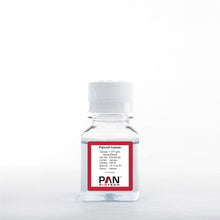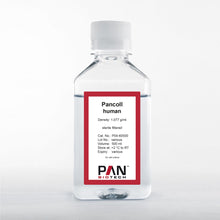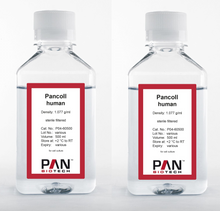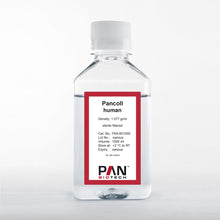Description
In many cases the isolation of cells is the first step for gene expression studies or in diagnostic procedures. Besides biological separation techniques physical separation methods are most commonly used. These methods use physical differences such as size and weight of the particles to be separated. For this purpose so-called separating solutions (also known as centrifugation media or density gradient media) are used.
Pancoll separation media from PAN-Biotech contain a polysaccharide with a molecular weight of 400,000 daltons. This hydrophilic polymer allows production of aqueous solutions for cell separation with a density of up to 1.119 g/ml. PAN-Biotech offers a variety of ready-to-use products with a density of 1.063 g/ml up to 1.119 g/ml for a very wide range of cell separation applications.
As the densities of blood fractions and the osmolality are different among species these parameters are optimized in Pancoll rat, Pancoll mouse and Pancoll animal.
Specifications
- Pancoll Human: Cell Separation Medium, Density: 1.077 g/ml
| Density: | 1.077 g/mL |
|---|---|
| EDTA: | without EDTA |
| Endotoxin Content: |
Pancoll Human: Endotoxin Content unspecified * If you need low endotoxin Pancoll, please see Pancoll Pro (LPS <0.1 EU/ml) |
| HEPES: | without HEPES |
| Liquid / Powder: | liquid |
| Product Category: | Cell Separation Media |
| Product Type: | Pancoll Cell Separation Media |
| Sterile: | Yes |
| Storage Temperature: | +2°C - RT |
| Manufacturer: | PAN-Biotech GmbH |
| Country of Origin: | Germany |
Composition
Polysucrose: ~ 57,000.00 mg/L
Diatrizoic Acid: ~ 86,900.00 mg/L
Method of Separation
Pancoll is available in different densities of the separation solution (e.g. 1.068 g/ml, 1.077 g/ml). The density is the key parameter to choose the appropriate solution for the target fraction (see table 1).
Table 1: Density of cell fractions of human blood
| Cell Fraction | Density (g/ml) |
| Thrombocytes | 1.040 - 1.060 |
| Monocytes | 1.059 - 1.068 |
| Lymphocytes | 1.066 - 1.077 |
| Basophiles | 1.075 - 1.081 |
| Neutrophiles | 1.080 - 1.099 |
| Eosinophiles | 1.088 - 1.096 |
| Erythrocytes | 1.090 - 1.110 |
Reference 1. Separation by Cell Size and Cell Density, Immunology (The Experimenter Series), Werner Luttmann, Kai Bratke, et al., Academic Press Publications 2006, ISBN-13 : 978-0120885442
If Pancoll human 1.077 is used, all fractions with higher densities (as indicated in the table above, which are basophiles, neutrophiles, eosinophiles and erythrocytes) will migrate to the bottom of the centrifugation tube. In this case, the purified fraction contains concentrated lymphocytes, monocytes and thrombocytes, also including trace of basophiles due to its density range. Accordingly Pancoll human 1.068 is suitable to isolate monocytes and thrombocytes. To isolate granulocytes we recommend to combine Pancoll human 1.077 and Pancoll granulocytes 1.119. Due to aggregation of erythrocytes induced by the Pancoll media granulocytes can be isolated from the red blood cells.
For lymphocyte separation blood is used which has been defibrinated or treated with anticoagulants (Heparin, EDTA, Citrate), and which is diluted one to three-fold, depending on the haematocrit level of the blood sample, with the required volume of a physiological saline solution. Then the Pancoll solution is carefully covered with a layer of diluted blood in a centrifuge vial, without mixing the phases. After a short centrifugation step (e.g. 800 g for 20 minutes) at room temperature the lymphocytes, together with monocytes and platelets, can be harvested from the white blood cells layer between the plasma sample layer and the Pancoll. The separated cells are then washed twice in physiological saline solution to purify the lymphocytes by removing platelets.
During centrifugation the cells of the blood sample migrate to the Pancoll layer where they get into contact with the polysaccharide contained in Pancoll. The red blood cells are aggregated by this substance at room temperature immediately. Aggregation causes an increase of the sedimentation rate of the red blood cells which aggregate together with the granulocytes as a sediment at the bottom of the centrifuge vial. Lymphocytes, monocytes and platelets are not so dense and cannot enter and pass through the Pancoll layer. These cells are concentrated as white blood cell layer above the Pancoll layer and therefore can be harvested easily by careful pipetting.
In subsequent centrifugation steps the lymphocytes are washed to remove remaining platelets, serum and Pancoll. As a result of this process a highly purified suspension of viable lymphocytes and monocytes (peripheral blood mononuclear cells [PBMCs]) is obtained.
Typical Results
| Lymphocytes | 60 ± 20 % | yield of Lymphocytes from original blood samples |
| 95 ± 5 % | of the Lymphocyte fraction are mononuclear Leukocytes | |
| > 90 % | live cells (trypan blue-exclusion) | |
| Other cells | 3 ± 2 % | Granulocytes |
| 5 ± 2 % | Erythrocytes | |
| < 0.5 % | total number of platelets of the original blood sample |
Storage conditions & stability
When properly stored, density gradient separation media are stable for at least 36 months. The storage period starts with the manufacturing date.
Resources
Related Products
Ilex Life Sciences LLC is an authorized distributor of PAN-Biotech products.








